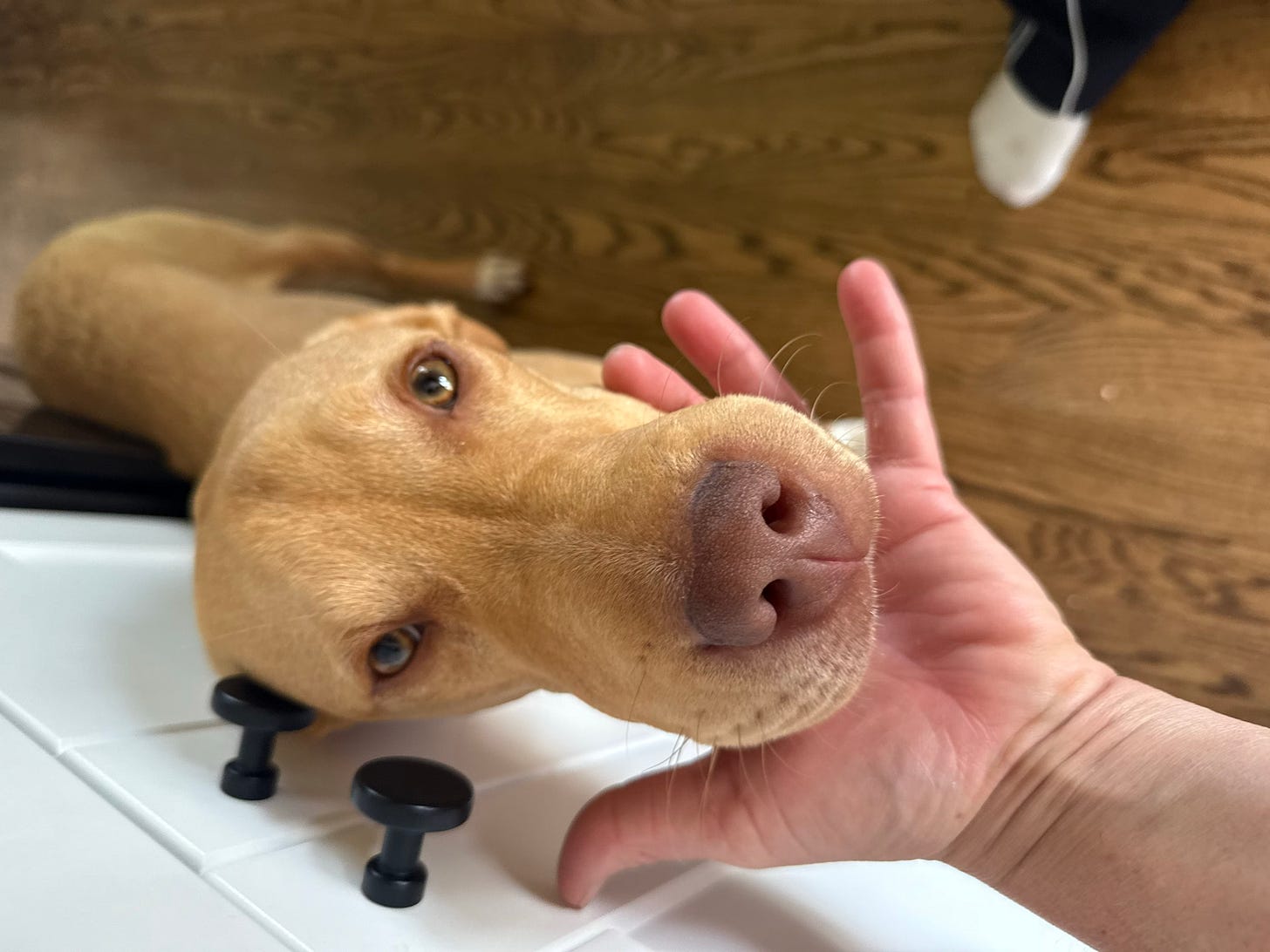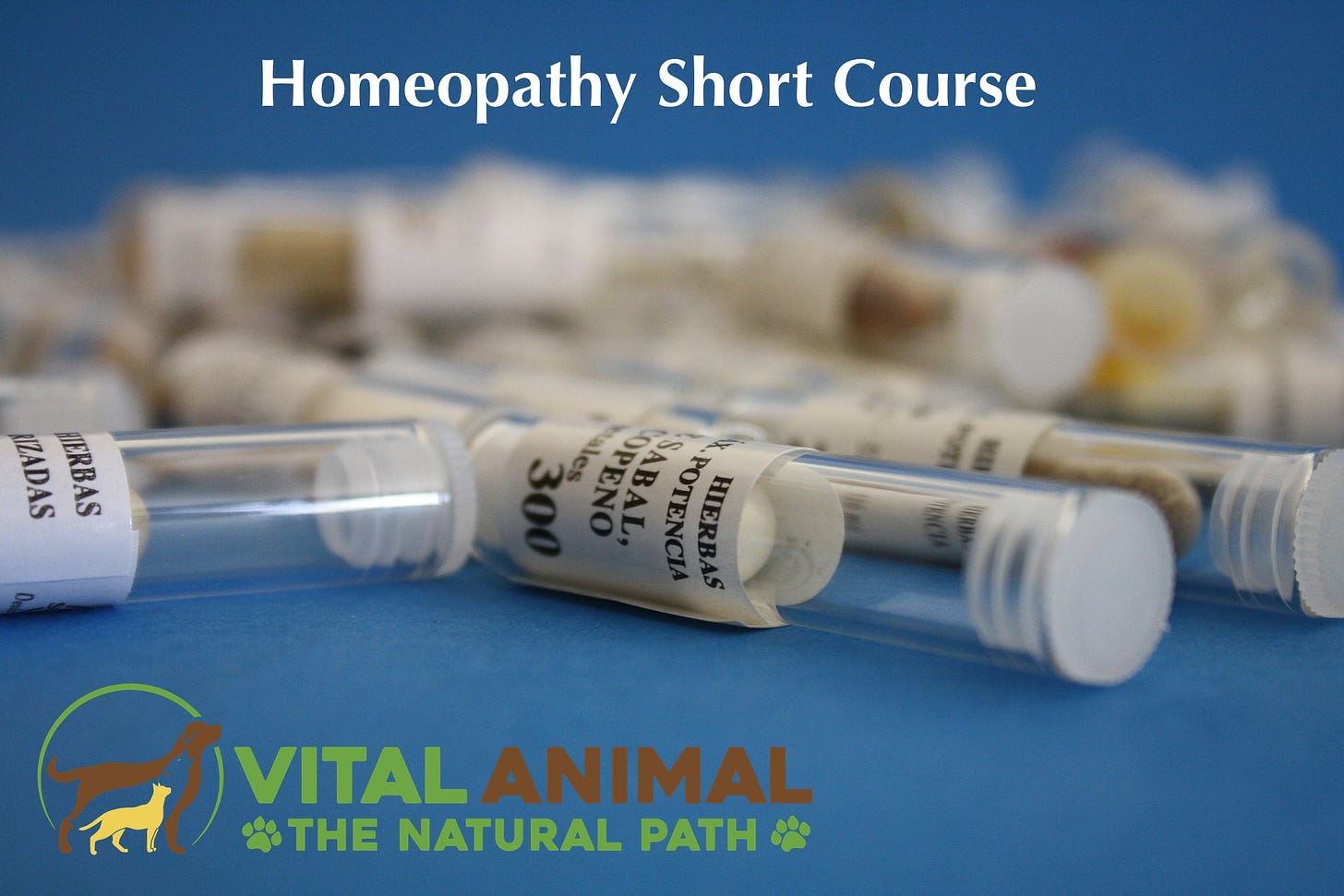Vital Animal News: April 6, 2025
Cute vs Functional / Neutering vs Ligaments / Shedding mRNA / Tip for Acute Swellings / Homeopathy Short Course Sale / and MORE
You Got a Headache, Frida?
“Science” Overlooks the Obvious Cause of Blown Knees
mRNA Clearly “Sheds.” Gulp.
Case Report: Homeopathy and the Face That Blew Up
HSC Sale
Along the Natural Path
Cuteness vs Function
Oh, don’t we love a cute doggie face?
They make us giggle, coo and fawn and they attract similar responses when these darlings are out in public.
And the dogs of course lap up all that attention.
At least until their genetically selected appearance causes outright disease in adulthood…
Skull vs Brain
Cavalier King Charles Spaniels are perhaps the most obvious example of a breed reaping negative repercussions due to people loving their baby like bulbous heads.
You’ll see the word “adorable” often used in reference to these, the smallest of the spaniels.
Bred to look like they are perpetual “babies,” the CKCS is a classic case of “ooo!” vs “oh oh.”
What hath breeding wrought?
Enter the Headaches
What people often miss is how this selection for cuteness comes at the price of a malformed skull, too small for these sweet dogs to allow their brains necessary space as they mature.
For a deeper exploration of this, this article in the main stream Veterinary Partner site tells the story of cramped head, its effects on cerebrospinal fluid, and pain.
The $40 word for this? Syringomyelia. SM for short.
The painful condition gets worse as these animals grow their brain without a consequent skull growth to house it.
Trouble is, the main stream enthusiast press often fails to mention these important breed defects.
Here’s the AKC headline I was sure would mention the anatomical issues:
“Cavalier King Charles Spaniel Facts You May Not Know”
But no, the “facts” were just more cuteness, how they were named, their four colors, their ownership by royalty, athleticism (with a headache? maybe they retire from athletics early…)
How common is this condition in the King Chas breed?
The Canadian Vet Journal in 2010 said,
“The incidence of CM [Chiari malformation] in the CKCS breed is an estimated 95% and current studies suggest that SM is present in more than 50% of dogs with CM (7) with approximately 35% of affected dogs exhibiting clinical signs (2).”
French Bull Dogs, Pugs, and More
Turns out, we humans also think smashed in faces are another cute feature in dogs.
That $40 word is brachycephalic, literally short headed.
I had a long distance Frenchie patient years ago, that had both defects. He would fall while playing, and couldn’t get up without help, much like a turtle on his back.
I struggled to make sense of what the owner was describing (a seizure??), but with a bit of searching online, I discovered this was quite common in the breed.
Taking a corner too fast, they’d fall, end up on their back, and flail wildly, unable to get up without assistance!
And it was a man made symptom that homeopathy was unlikely to be able to effect, as it was pure malformation affecting the spinal cord.
Again, due to looks trumping function.
But How to Breath?
These smashed in face breeds are known for respiratory challenges as well.
In what must be in the top 3 of ugly abbreviations, BOAS (Brachycephalic Obstructive Airway Syndrome) is what vets are trying to fix, now that there’s an abundance of this man made disease in the world.
Here’s a short description of what these animals suffer:
BOAS dogs have grown an entire subset of veterinary surgery, which I’m sure makes some surgeons rich. A snip of tissue here, a shortening of an elongated palate there, some laser cutting, and your dog may be able to breath again.
How Did We Get Here?
Societally, I think we have to ask that.
Animals with these conditions would obviously never have survived in the real world.
But, in the name of cuteness, we’ve kept them alive, bred them to each other, and continued these lines for our own… what exactly?
Entertainment? Glee?
More Importantly: How do we Fix This?
I’ve personally never been attracted to these dogs, though I see why some owners are.
By and large, Pugs and Frenchies have lovable personalities, in my experience.
(I never saw a King Chas in my practice days, but word on the street is they are real sweeties.)
The odds of these types of breed dying out are slim, at least as long as they have their human admirers. French Bulldogs were the most popular breed, unseating the Labrador not too long ago.
If I was ever asked about breed choices by a potential buyer (a rare question in 40 years of practice), I’d always lean to long noses, erect ears with lots of air exposure, medium to long straight legs, and short coats that didn’t tangle or pick up burrs.
There’s a reason wolves and coyotes and dingos have thrived, even under difficult, competitive circumstances.
Perhaps we simply need to look to what’s worked for millennia in the canine world and buy the breeds that match those archetypes?
The BOAS surgeons aren’t going to starve, I’m sure, but owners of naturally shaped dogs would be more likely to have healthy, long lived loved ones with minimal expense.
Especially if they avoid over “prevention” from the broken conventional veterinary profit machine.
You know what I’m talking about there…
Dogs Who Blow Their Knees
Research Has (some…) Answers
You may already know, if you’ve seen my earlier article on cranial cruciate ligament rupture (CCLR), that “stepping in a hole” is rarely the reason a dog blows out his knee.
No, it’s an autoimmune inflammation that precedes the condition, and what’s the greatest contributor to self inflammation?
Yep: vaccination.
Immune confusion reigns when you bypass all of Mom Nature’s defenses and install a slew of viruses more or less immediately into the blood stream.
Self directed inflammation is a common part of immune confusion.
“Science” — Ignoring the Uncomfortably Obvious
It’s disappointing to see researchers calling the disease “a complex polygenic disease with high heritability” while ignoring vaccines as a chief cause.
At least they recognize that, in their study of Labs (apparently a “predisposed breed”), the timing of neutering is significant.
If you’re choosing to neuter any animal (you may want to review the risks vs benefits here first), their research findings are clear on Labs:
Neutering prior to 12 months of age significantly increased risk for CCLR development…”
And, that was the finding in so many diseases in my link just above, from joint disease to incontinence to cancer.
Veterinary convenience is the only reason to neuter early.
And, as you’re the one that’ll bear the brunt of diseases and costs associated with early neutering, it should be obvious that you’ll want to stall neutering, if you choose it at all.
That’s the reason my earlier article got the headline, Neuter or Not? And When?
It’s no small decision to take gonadal hormone factories from a living creature. Think about it responsibly before you rush in.
Even if "everyone else is doing it.” They are not in many other countries, as I point out in the opening of the article.
And interestingly, those countries who are not blindly neutering every dog they can are not inundated with unwanted pets nor escalating euthanasia rates. Hmmm…
mRNA shedding is real
Since we covered animal vaccine shedding in the last issue, I thought I’d add the human experience with the mRNA “vaccines” (more properly called “gene therapy” per some medical voices I trust).
The Midwestern Doctor, who publishes on Substack regularly has, with Pierre Kory, MD studied this by carefully taking cases of those reporting what appeared to be illness in the unvaccinated after close association with recently mRNA jabbed people.
Most immediately striking was women reporting abnormal menstrual cycles after years of normal cycling.
As this is human stuff, I’ll let you dig in.
The Midwestern Doctor’s piece:
And Dr. Kory’s research:
What I don’t know so far (links to research welcome in the comments) is “Do ALL mRNA injections shed? Or was that just a feature of the “shot heard round the world?”
As more knowledge is gained, I’ll have more on veterinary “vaccines” built on this gene therapy platform.
p.s. Perhaps as we might expect, main stream search engine AI hasn’t caught up yet.
From Kagi, the search engine I’ve chosen to pay for, in answer to my query “are all mRNA injections expected to shed?”:
Yandex, the Russian search engine more famous for image searching, leads with more certainty (or at least more readily allows the shedding possibility exists):
Tasty Tips: Acute Swelling!
As our acute veterinary homeopathy membership group, Vital Animal Alpha, is scheduled to open to new members soon, I thought you might like to take a peek into a recent post in our private discussion group.
Cabernet has been helping a friend with her dog, and in addition to sound raw diet advice, she helped pull this pup, Bucky, out of a tailspin with pneumonia that two rounds of conventional antibiotics hadn’t touched.
He got better with a couple doses of a well chosen remedy Cabernet suggested.
It’s hard to visualize pneumonia, even if you’re right next to it, but last week, Bucky presented with something far more obvious:
YOUCH, right?
No obvious cause, but that sudden swelling would suggest a bee or wasp or hornet may have been licked on and responded defensively with a stinger in the lip!
Cabernet, recognizing this, quickly recommended an old remedy friend called Apis mellifica, which her friend had in only one rather low potency, called 6C.
Give it!
Then she suggested getting out a kitchen appliance that would be used for Bucky’s next dose: a blender.
(We giggled a bit, because a colleague maybe some of you know, Dr. Steve Blake, once got the honorary (tongue in cheek) title of “Blind Blender Blake” during our training in the early 90’s. Alpha students learned from me that Steve had shared some of his early homeopathic escapades on himself (!) that earned him that nickname.)
Cabernet suggested a water dose 15 minutes later, using the blender to slightly increase the potency of the remedy.
And this was the result a mere 30 minutes from the first dose:
You can tuck this away in your notes somewhere (I use Evernote), because Apis, made from the bee, is invaluable for acute swelling that appears suddenly, and looks like a bee sting, even if no bee is involved.
Another Alpha student found it so effective when he’d get a sudden allergic reaction during farm work that it took the place of his Epi pen!
He even saw resolution of the tight breathing, as an anaphylactic reaction can produce, thanks to this fine remedy.
Bucky had none of the difficult breathing, but if he did, odds are Apis would have quickly rectified that as well.
Apis. One of those acute remedies to make friends with.
Nice work, Cabernet!
Homeopathy Short Course Sale
As we near the open enrollment period to our monthly membership called Vital Animal Alpha, I’ve just put my sweet Homeopathy Short Course on sale for you.
Until we open the doors to Alpha enrollment on the 16th of April, take 50% off this great intro course and discover:
What is (and isn’t) homeopathy
How remedies are made
How does medicine so extremely diluted still work?
And some acute remedy tips that will always be useful to you and your loved ones. And friends and neighbors. And neighbors’ dogs… you get the picture.
It’ll be the best 20 bucks you spend this year, guaranteed.
Here’s where to get in at a steep discount, if you haven’t already joined us:
Along the Natural Path
When a herd of bulls decides to walk the road, well, they pretty much do it however they choose to. These guys are walking into traffic, and semi-oblivious to car horns and myriad motorbikes who also have places to go.
This shopkeeper knows they’ll pass her stall by if she waves a small stick and shouts a bit.
I’ve had a dog or two tentatively take up a chase when I’ve bicycled past lately. Knowing outrunning them is not possible, I stop, turn, and holler a one syllable “HUT!” (leave it/git!!). Any villager within earshot immediately joins the chorus, and the dog backs down, deciding I’m not worth it.
The villagers are busy getting two crops harvested before they plant rice: wheat and black mustard.
This is the view from my balcony a week ago:
And another yesterday, after steady handiwork has been taking place with small sickles:
And, not only is most of the labor of harvest done by hand here, so too is transport:
Our lovely spring weather has left us with just some cool mornings now. The days are heating up to 102º F. and destined for greater heights as April wears on.
Luckily, I’m part of a group getting ready to head for the hills just after the next issue. “Hills” is really foothills of the Himalaya, my healthiest place here in India.
Where ever you call home, keep on making wise choices for those innocents in your care.
Until next time,
Will Falconer, DVM
























Great information!!!!
Thanks for the write-up on bulb head/short snout dogs. I think we’ll stick with our GSDs. Our current “mutt” is part Czech, part East German and was quite a handful when younger, but now three and such a good girl!